 |
The Bead SiteHome>Ancient Beads> Middle East > Indian Ocean Trade 2
Early Navigation and Trade in the Indian Ocean (Ravenna, Italy 4-7 July 2002)
Is.I.A.O. (Istituto Italiano per l'Africa e l'Oriente),
UniversitÓ di Bologna - Sede di Ravenna
Dipartimento di Archeologia dell'UniversitÓ di Bologna and Fondazione Flaminia
|
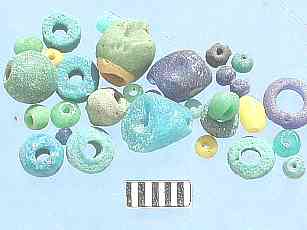
|
THE BEAD TRADE IN THE INDIAN OCEAN, WITH SPECIAL REFERENCE TO BERENIKE, EGYPT (Part Two)
Pete Francis
|
|
Beads are helping to clarify some of the demographics at Berenike.
|
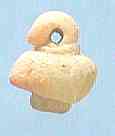
|
A pendant in the shape of a jug (left) is regarded by some as a Christian symbol. Not everyone agrees that it is, but a nacreous (mother-of-pearl) cross (right) was being manufactured at Berenike.
|
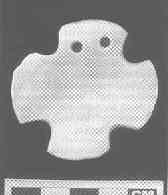
|
|
|
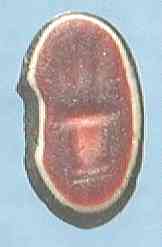
|
A glass cabochon-seal is unusual in that it has translucent red glass in it, quite rare for this time. Engraved into this cabochon, probably used as a seal, is a device representing a Zoroastrian fire altar. Similar devices are known on Sasanian stone seals.
|
|
|
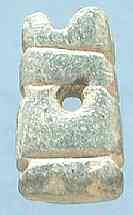
|
A small steatite (soapstone) Roman fire altar pendant was also found (left). Here we have a Roman pagan device. There was also a small Bes pendant (from nearby Shenshef; (right) and an unusual molded glass scarab, both symbolic of the Egyptian pagan religion.
|
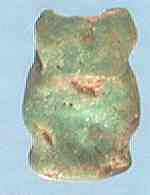
|
|
The beads give us evidence of people belonging to four different religions. Of course, we also have the evidence of the temples and the church, but there is no other archaeological evidence for a Zoroastrian (most likely from Persia) having been at Berenike.
|
Another clue to the nature of Berenike's population lies in some beads made of the marine shell Conus. There were made both by piercing the whole shell and by removing the spire and piercing it to make a discoidal bead. They were certainly not made for export. The shell bead most connected with ancient Egypt is the cowry, but no cowry beads were at Berenike (there are cowries around, but none were made into beads.)
|
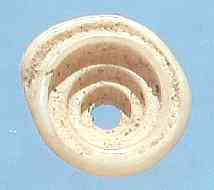
|
|
Inland people especially value shell beads. The modern Ababda Bedouin wear cowry and "paper" or "little bubble" (Atyidae ) shells. Both of these (and Conus) are available in the Red Sea; next time I will have to ask where they obtain these shells. No doubt the ancestors of the modern Ababda Bedouin were the desert nomads, the people the Romans called "Blemmyes." While the Blemmyes at Berenike were not really "inland" people, their orientation would have been. I believe that they wore the Conus shells
While one Conus shell bead was dated to the Flavian period (it could be an intrusion), all the others were in late contexts, from the fourth to the sixth centuries. Other evidence, including the ceramics and the food refuge, have suggested to other specialists that the Blemmyes became the dominant faction of the Berenike population in these later centuries, and these beads confirm that.
|
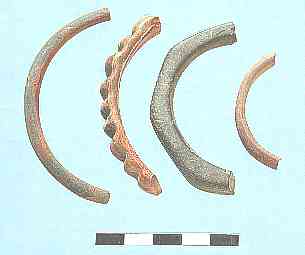
|
One more demographic note concerns the glass bangles (solid bracelets), whose fragments are found in considerable numbers in the later centuries. (No, they are not beads, but I always get stuck studying them anyway). Similar bangles have been found in Palestine at the same period. Virtually no one has ever studied them (but see Spaer 1988, 1992). Who wore them? Can they help us answer the question as to whether woman lived at Berenike?
Left: bangle profiles. Below: bangle tops.
|
|
I do not have the entire answer yet, but several things are now clear. Men did not wear them. Neither did wealthy women; they are too clumsy for that. Middle class women are recorded with them in Palestinian graves. One archeologist I asked who has seen them in Roman military areas told me that he always thought prostitutes wore them. Servants might also have worn them. Certainly, they indicate the presence of apparently quite a few women, but what the function of the women at Berenike was cannot yet be determined.
|
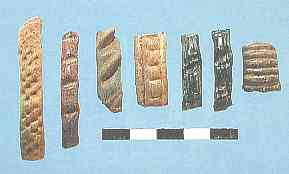
|
|
Part Three: Other Things the Beads Can Tell Us
Small Bead Businesses | Beading & Beadwork | Ancient Beads | Trade Beads
Beadmaking & Materials | Bead Uses | Researching Beads | Beads and People
Center for Bead Research | Book Store | Free Store | Bead Bazaar
Shopping Mall | The Bead Auction | Galleries | People | Events
The Bead Site Home | Chat Line | Contact Us | Site Search Engine | FAQ
|
 |









